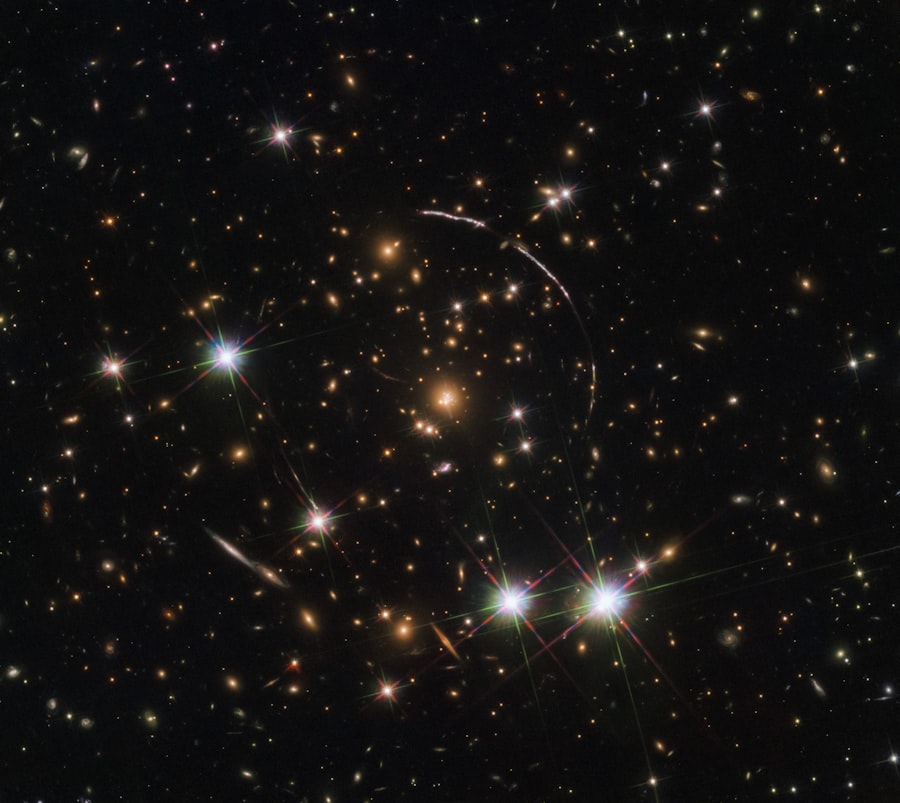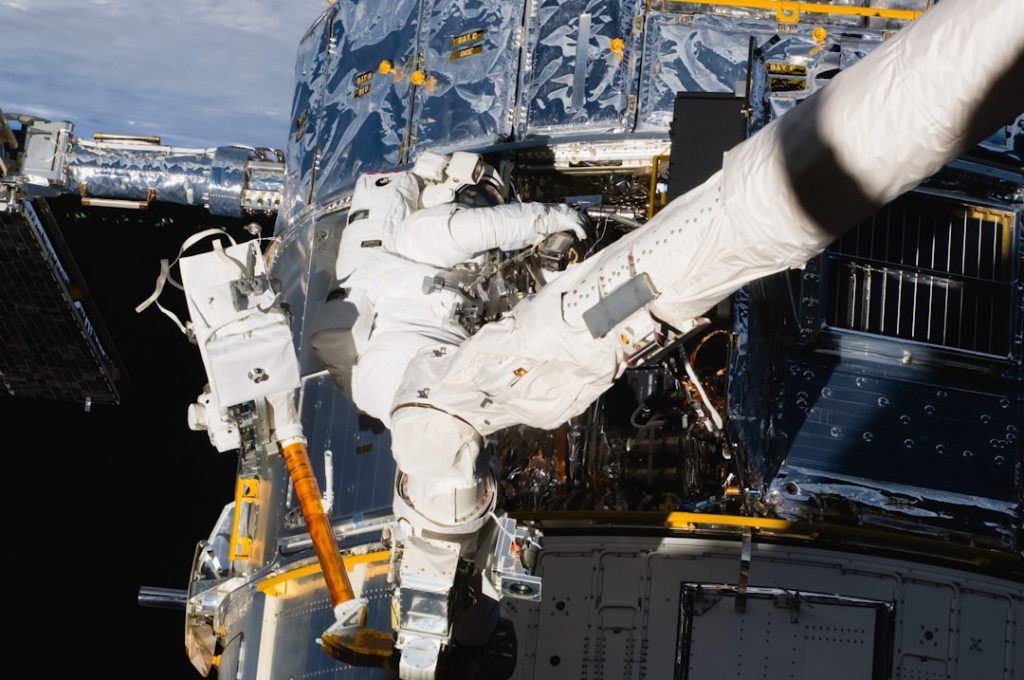The Hubble Space Telescope, a marvel of modern engineering and scientific ingenuity, has revolutionized our understanding of the universe since its launch in 1990. Positioned in low Earth orbit, Hubble operates above the distorting effects of Earth’s atmosphere, allowing it to capture images and data with unparalleled clarity. This observatory has provided astronomers with a powerful tool to explore the cosmos, revealing phenomena that were previously beyond our reach.
With its ability to observe in various wavelengths, including ultraviolet, visible, and near-infrared light, Hubble has opened new avenues for research and discovery, making it one of the most significant instruments in the history of astronomy. Hubble’s design is a testament to the collaborative efforts of scientists and engineers from NASA and the European Space Agency (ESA). The telescope is equipped with a 2.4-meter primary mirror and a suite of advanced instruments that enable it to conduct a wide range of astronomical observations.
Its capabilities have not only enhanced our knowledge of celestial bodies but have also inspired generations of scientists and enthusiasts alike. As we delve into the history, contributions, and future of the Hubble Space Telescope, we will uncover the profound impact it has had on our understanding of the universe.
Key Takeaways
- The Hubble Telescope is a space telescope launched into low Earth orbit in 1990 and is still in operation today.
- The Hubble Telescope has made significant contributions to astronomy, including measuring the rate of expansion of the universe and discovering new planets and galaxies.
- The Hubble Telescope has captured stunning images of celestial objects, including the iconic Pillars of Creation in the Eagle Nebula and the Hubble Deep Field image.
- The Hubble Telescope has made groundbreaking discoveries, such as the identification of dark matter and the observation of the first organic molecule on an exoplanet.
- The future of the Hubble Telescope includes continued operation and potential upgrades to extend its scientific capabilities.
History of the Hubble Telescope
The inception of the Hubble Space Telescope can be traced back to the early 1940s when astronomer Lyman Spitzer first proposed the idea of a space-based observatory. Spitzer recognized that ground-based telescopes were limited by atmospheric interference, which blurred images and restricted observations. His vision laid the groundwork for what would eventually become Hubble.
However, it wasn’t until the 1970s that serious planning began, culminating in the launch of Hubble aboard the Space Shuttle Discovery on April 24, 1990. The initial excitement surrounding Hubble’s launch was soon tempered by disappointment when it was discovered that the telescope’s primary mirror had a spherical aberration due to a manufacturing error. This flaw resulted in blurry images that fell short of expectations.
However, rather than abandoning the project, NASA and its partners devised a plan to correct the issue. In December 1993, astronauts aboard the Space Shuttle Endeavour conducted a servicing mission that involved installing corrective optics, which restored Hubble’s vision and allowed it to fulfill its potential as a premier astronomical observatory.
Hubble Telescope’s Contributions to Astronomy

The contributions of the Hubble Space Telescope to astronomy are vast and varied, spanning numerous fields of study. One of its most significant achievements has been in the realm of cosmology, where it has provided critical insights into the expansion of the universe. By observing distant supernovae and measuring their brightness, astronomers have been able to determine that the universe is not only expanding but that this expansion is accelerating due to a mysterious force known as dark energy.
This groundbreaking discovery has reshaped our understanding of fundamental cosmological principles. In addition to cosmology, Hubble has made substantial contributions to our knowledge of galaxy formation and evolution. By capturing images of galaxies at various stages of development, Hubble has allowed astronomers to piece together the history of these massive structures.
Observations of distant galaxies have revealed that they were much more active in their formative years than previously thought, leading to new theories about how galaxies grow and interact over time. The telescope’s ability to peer deep into space has provided a glimpse into the early universe, offering clues about how galaxies like our Milky Way came to be.
Captivating Images Captured by the Hubble Telescope
| Image Name | Location | Date Captured | Description |
|---|---|---|---|
| Pillars of Creation | Eagle Nebula | 1995 | A stunning image of interstellar gas and dust columns in the Eagle Nebula. |
| Hubble Deep Field | Various | 1995 | An image of a small region in the constellation Ursa Major, showing thousands of galaxies. |
| Sombrero Galaxy | Virgo Constellation | 2003 | A beautiful image of a spiral galaxy with a prominent bulge and a bright nucleus. |
| Carina Nebula | Carina Constellation | 2007 | An image of a large, bright nebula that is home to many young stars. |
One of the most captivating aspects of the Hubble Space Telescope is its ability to capture stunning images that not only serve scientific purposes but also inspire awe and wonder among the public. The telescope has produced iconic images such as the Pillars of Creation in the Eagle Nebula, which showcases towering columns of gas and dust where new stars are being born. This image not only highlights Hubble’s technical prowess but also serves as a visual representation of the dynamic processes occurring in our universe.
Another remarkable image captured by Hubble is that of the Hubble Deep Field, an observation made in 1995 that involved pointing the telescope at a seemingly empty patch of sky for an extended period. The resulting image revealed thousands of galaxies, some dating back billions of years, providing a glimpse into the universe’s past. This groundbreaking observation underscored the vastness of space and our place within it, igniting curiosity and prompting further exploration.
Such images have become emblematic of Hubble’s legacy, showcasing not only its scientific capabilities but also its role in bridging the gap between science and art.
Discoveries Made by the Hubble Telescope
The discoveries made by the Hubble Space Telescope are numerous and transformative, fundamentally altering our understanding of various astronomical phenomena. One notable discovery was the identification of exoplanets—planets outside our solar system—through direct imaging techniques. Hubble’s observations have allowed astronomers to study the atmospheres of these distant worlds, providing insights into their composition and potential habitability.
This research has opened up new avenues in the search for extraterrestrial life. Hubble has also played a crucial role in studying black holes, particularly supermassive black holes located at the centers of galaxies. By observing the motion of stars around these enigmatic objects, astronomers have been able to infer their presence and measure their masses with remarkable precision.
The data collected by Hubble has contributed to our understanding of how black holes influence galaxy formation and evolution, shedding light on one of the most mysterious aspects of astrophysics.
Future of the Hubble Telescope

As we look toward the future, the Hubble Space Telescope continues to be an invaluable asset for astronomers worldwide. Despite being over three decades old, Hubble remains operational and continues to produce groundbreaking science. However, as technology advances and new telescopes are developed—such as the James Webb Space Telescope (JWST)—questions arise about Hubble’s role in an evolving landscape of astronomical research.
NASA has committed to maintaining Hubble’s operations for as long as possible, with ongoing servicing missions having extended its lifespan beyond initial expectations. These missions have not only repaired and upgraded instruments but have also ensured that Hubble remains competitive with newer observatories. As long as it continues to function effectively, Hubble will complement other telescopes like JWST by providing unique observations that enhance our understanding of cosmic phenomena across different wavelengths.
Impact of the Hubble Telescope on Scientific Understanding
The impact of the Hubble Space Telescope on scientific understanding cannot be overstated. It has fundamentally changed how we perceive our universe and our place within it. By providing clear images and precise measurements, Hubble has enabled scientists to test theories about cosmic evolution and refine models that describe how galaxies form and interact over time.
Its contributions have led to significant advancements in fields such as astrophysics, cosmology, and planetary science. Moreover, Hubble’s findings have sparked public interest in astronomy and science as a whole. The breathtaking images it produces have captured imaginations worldwide, fostering a sense of wonder about the cosmos.
This public engagement is crucial for inspiring future generations of scientists and researchers who will continue to explore the mysteries of space. The legacy of Hubble extends beyond its scientific achievements; it has become a symbol of human curiosity and our relentless pursuit of knowledge.
How the Public Can Access Hubble Telescope Data
One of the remarkable aspects of modern astronomy is its commitment to open data access, allowing both scientists and enthusiasts alike to explore findings from major observatories like Hubble. The data collected by Hubble is made available through various platforms managed by NASA and ESThe Mikulski Archive for Space Telescopes (MAST) serves as a primary repository for Hubble data, where users can access raw images, processed data products, and catalogs. Members of the public can engage with this wealth of information through user-friendly interfaces that allow them to search for specific observations or browse through extensive collections based on different criteria such as celestial objects or observation dates.
Additionally, educational resources are available to help users understand how to interpret data and images effectively. This accessibility not only democratizes scientific knowledge but also encourages citizen science initiatives where amateur astronomers can contribute to ongoing research efforts using professional-grade data. In conclusion, the Hubble Space Telescope stands as a monumental achievement in human exploration and understanding of the universe.
Its history is marked by challenges and triumphs that reflect both human ingenuity and resilience. The contributions it has made to astronomy are profound, reshaping our understanding of fundamental cosmic principles while captivating audiences with its stunning imagery. As we look ahead, Hubble’s legacy will undoubtedly continue to inspire future generations while paving the way for new discoveries in an ever-expanding universe.


